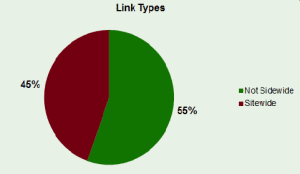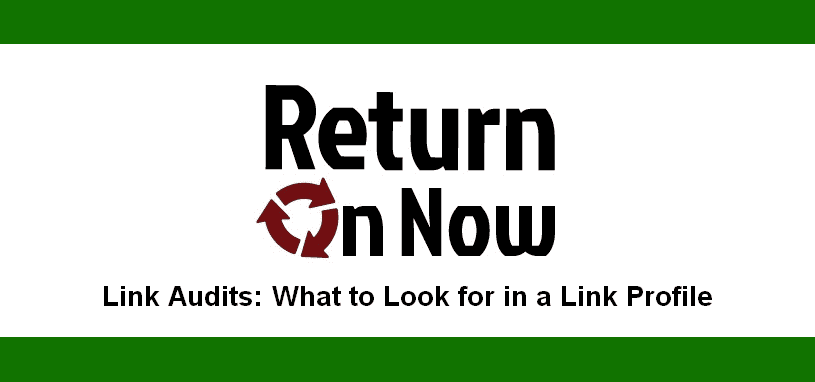Since last April, when Google rolled out the Penguin update to penalize link manipulation tactics, interest in link audits has been at an all time high. The days where any link added authority value to your site are over. Now, you need links from the right sites with the right anchor text.
Link Profiles: The First Step in a Link Audit
Of course, if you want to audit a large set of data, you need some way to prioritize where you spend your time. Depending on the size, age, and popularity of your domain, you could literally have tens of millions of backlinks or more. It is impractical to think you can do a manual review of each link individually, so you need a way to tighten your focus for a deep dive.
I always start out with a link profile. This analysis is very useful, as it helps you identify the likelihood that there are questionable links to investigate further. If you build a good link profile, it will eliminate well over half of the effort a deeper dive would require.
What to Include in a Link Profile
There are several important metrics that should be part of any thorough link profile. You will want to pull these together visually, so brush up on your chart making skills in Excel or whatever your data analysis tool of choice may be.
Backlink Volume Trended Over Time
Since Penguin is aimed at preventing link manipulation, this is the obvious place to start. When I sign on a new client for a link audit, I always begin by looking at the pace of link acquisition over the previous six months.
This highlights two data points – the overall volume of individual links, and any bursts of addition or loss of links. If you see spikes in volume or other unexpected behavior, it indicates potential manipulation.
Keep in mind that it is possible to add thousands of links naturally in a very short period of time, but you should be able to identify some event that coincides with the burst. If you cannot, time to investigate.
Types of TLDs Linking
Top Level Domain (TLD) type is another factor worth evaluating. A normal link profile will have a healthy mix of TLD types, with .COM leading the pack. If you see a link profile with 99% .COM TLDs linking, that is a cause for concern.
Also important is to consider what volume of links derive from .EDU and .GOV domains. Links from these domains have long been seen as the highest authority links possible. The thinking is that educators and bureaucrats will only link to sites they truly advocate, so manipulation is too hard for most of us to pull off.
Top Anchor Phrases by Page and TLD
Anchor phrases are exact match text, and can often be a longtail term. It is important to look at anchor phrases, specifically to identify potential risk with anchor text. These phrases should be a mix that includes branded and competitive keywords.
If you look at your top 10 anchor phrases by page or domain, and find that all 10 are money keywords, look out. This is precisely the type of stuff that can lead to problems from Penguin.
Top Anchor Terms by Page and TLD
Anchor Terms are the individual words included in anchor texts. For example, I would expect to see anchor texts including the words “Return” and “Now” show up among the top 10 for this website.
Sometimes link building vendors are savvy enough to mix up the anchor text via paraphrasing. This set of data will be useful in identifying competitive keywords that represent too much of your overall link profile.
For example, if you are an ecommerce site selling mobile phones, but ear buds are your highest ranked anchor term, you probably hired someone to help you rank for that term at some point in the past. Google won’t care that you acquired the link within the guidelines they set five years ago. It is up to you to fix problems like this now.
Link Types: Persistent vs. In Body Content
Where a link appears is immensely important to how Google values it. Although a thousand links may be coming from a perfectly reputable site, there are situations where only one link on a TLD counts.
When does this happen? When a link is acquired in persistent content, e.g. in the footer, on the sidebar, in the nagivation, or anywhere else that appears on all or most of the templates of your website. This is also often referred to as “sitewide” links.


If you find more than 20% of total links in persistent content, your site has much less link juice than you thought. I did a link profile exercise recently where 45% of their overall link inventory was in persistent content (see chart to the right). This will likely discredit close to 1/3 of their total link count.
When working with a link building vendor, always require detailed reports on where they are placing links. Otherwise, they can take credit for adding hundreds of backlinks that only count as 10 to Google.
Mix of NoFollow to DoFollow Links
Up until the last year or two, Google ignored NoFollow backlinks for the most part. NoFollow tells web crawlers / spiders not to even click through to the destination page, so the link was treated as just another piece of content.
Those days are over. Now that Social Media is being incorporated into Google’s algorithm, they have to take NoFollow seriously. Otherwise, Social activity could not be factored into the equation, since most social networks automatically apply a NoFollow directive to shared content.
While you do not need a 50/50 split between the two, you also don’t want DoFollow to exceed NoFollow by a 45/1 ratio. Some backlinks will naturally come as NoFollow (e.g. on blogs), and nearly any social share will be the same. Don’t just pursue “DoFollow” links, because a site with almost no social shares or NoFollow backlinks will be suspect to Google. In today’s environment, it is virtually impossible for this to happen naturally.
If you have been pushing back on adding social sharing icons to your website, it’s time to catch up.
Summary
Link profiles are very important for identifying potential areas of concern. Once you have all of this information documented, you will know the right priorities to focus on when digging deeper into the link audit.
There are a number of tools available to help you complete this exercise. At a minimum, you will need access to Google Webmaster Tools to get started. I’m a huge advocate of Bing Webmaster Tools as well, so get connected on there if you have not already. If you can afford them, SEOmoz’s Tools and Majestic SEO also offer excellent link analysis features that are worth incorporating into the analysis.
Tommy Landry
Latest posts by Tommy Landry (see all)
- PPC for Car Dealerships – How This Niche Differs From The Others - July 23, 2024
- Trademarks in PPC – What You Need to Know and What to Avoid - July 16, 2024
- PPC Trends and Statistics for 2024 - July 9, 2024





